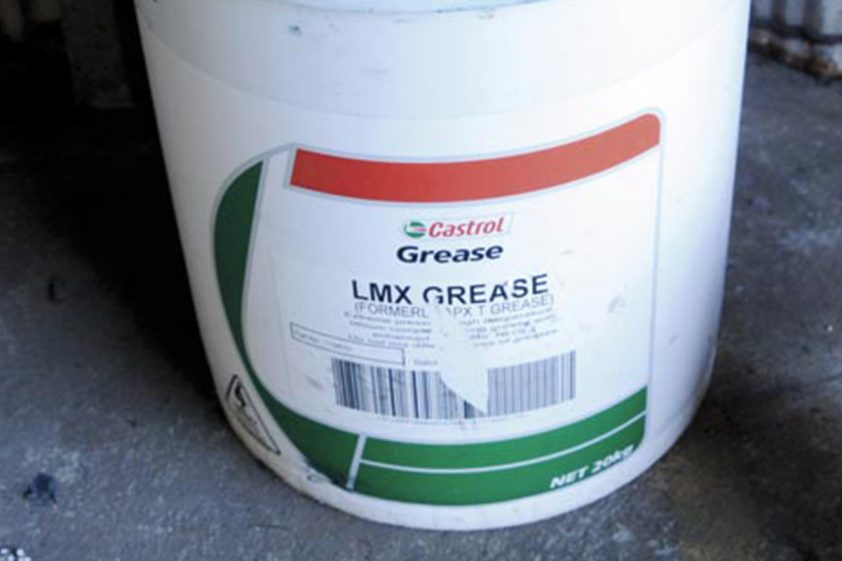Grease is a wonderful invention. Not only does it remove friction between moving parts but it insulates and prevents corrosion. Nevertheless, it is still prone to failure and degradation over time.
What is grease?
Typically grease is a liquid oil mixed with a thickener and additives to create a semi-solid lubricant. It’s useful in areas where liquid lubricant cannot be used.

When it comes to RVs, it is typically used for wheel bearings, suspension joints and tow hitches. Additional uses in the wider world include in the medical field and to keep door hinges squeak-free around home. Being oil-based, grease also helps prevent rust forming on metal parts and has excellent insulating properties.
Ingredients
Oil makes up around 80 to 97 percent of grease. The type of oil used determines the grease’s shear-thinning properties. Shear-thinning refers to the change in viscosity from semi-solid to liquid under compression or heat; think of it as the change in the thickness of the grease when melted to near the viscosity of the base oil.
If grease gets too thin, it can run away from what it is meant to lubricate; whereas, if it is too thick, it might fail to penetrate into areas needing lubrication. Therefore, the shear-thinning properties of grease, that is the viscosity of the base oil, is all-important.

The next most important ingredient is the thickener. As oils are liquid and we need grease to be thick and sticky, manufacturers use thickeners. The most common one may surprise you. It’s soap. Yes, soap. You might think of it as an odd partner to oil, given that soap tends to emulsify oils. However, we’re not talking about hand soap, but about industrial soap designed specifically for this use. The issue with this commonly used thickener is that it tends to enjoy the company of water, so naturally degrades in the grease over time.
Fine minerals like clays are also commonly used as thickeners. These are less prone to degrading but tend to be harsher than soap-based grease, so are used in industrial and open-air lubrication; for example, for the joints on massive earthmoving machinery.
The third most common thickener is lithium. This is the most heat-resistant, but ensure you don’t apply it anywhere it may come in contact with water, as it is the most soluble of greases.
The last ingredient of grease is additives. A bit like the ‘stabilisers’ or ‘preservatives’ in the list of ingredients in your peanut butter, these additives could be a lot of things – but they tend to have the purpose of keeping the soap or other thickeners healthy for longer. They constitute very little of the grease’s make-up, so do not sweat on them.
What goes wrong with grease?
The most common issue with grease comes from the base oil oxidising. As oil oxidises, the resulting oxidants can react with the thickeners, breaking down their ability to keep the grease thick. This can lead to your grease becoming runny and useless.
The most obvious signs of degradation are darker grease colour and reduced thickness. These changes happen over time but can be exacerbated by excessive heat (heat outside of the grease’s operating range) or the introduction of contaminants like petrol and other oils, including car waxes.
You should always keep an eye on your bearing grease and use the right grease for the job. Some areas, like bearings, are hot-zones where pressure and movement create friction and in turn heat. Here it is vital to have the right grease to lubricate the moving parts and mitigate the heat. Your grease will have a heat range; look for it, and also investigate the label to find out which applications the grease is appropriate for.
The good news is that in all my time spent using grease when replacing bearings and axles, or greasing machinery parts like compressors, I have never found a grease that does not clearly state its use on the packet. So, if you take a minute and read the label for instructions, you should never go wrong.
MEET THE AUTHOR
Tim van Duyl
Coming from marine publishing Tim now oversees Caravan World and Trade-a-Boat for the Adventures Group as their Senior Editor. With experience garnered from travelling the breadth and width of his home country New Zealand in all manner of ways, his mission is to see all Australia has to offer. Having already sampled Cape York, Murray-Sunset National Park, Wilsons Promontory and the bulk of Victoria’s West, he has plans to add to the small parts of WA and NT already seen. When not on the road you can find Tim passing time at lakes around Australia or in the high country camping with his close friends and family with the Murrindindi a popular spot.





